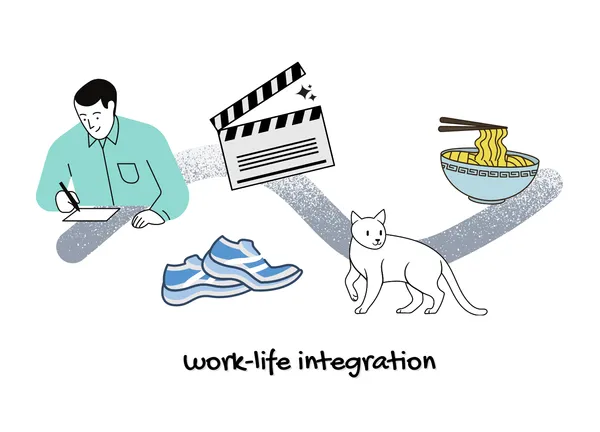Work-Life Integration
This blog post is in accordance with episode four of the podcast on Work-Life Integration with with Abby Ma.
We’re often bogged down by the many different things we need to do - whether it’s meal prepping, cleaning, folding our laundry, working, answering an email, doing some type of physical activity, playing some games, or taking time to relax, it can get overwhelming to juggle everything. To have some type of semblance of sanity, we are typically told to strive for a “work-life balance” or equilibrium between our professional lives. But we all know that’s easier said than done. In the podcast episode, Abby uses the term “work-life integration” instead and I found myself gravitating towards this because balance assumes that you are working towards equality but that can be difficult to accomplish regularly. For example, there might be some days or periods of the year where work is busier than others or during the holiday season you tend to travel or spend more time with loved ones. Much like intentions, you are aiming towards integrating various aspects of your life into your day based on what your capacity is. If you have more tasks to work on that take you past 5 pm and you have less time for relaxation and fun, you might look for ways to integrate activities that help you wind down at the end of the night. It could be talking on the phone with your parents while you go for a walk or dedicating at least one hour before sleeping to no tech use.

The Canadian Mental Health Association noted that 58% of Canadians reported that they felt “overloaded” with all of the different areas in their lives. While having some level of stress can help improve your resilience, patience, and efficiency, it can harmful over time if it continues to build up. Having high levels of stress that is unmanaged could lead to unhealthy coping mechanisms like procrastination and ruminating. This is also known as avoidance coping, which is defined as “a maladaptive form of coping in which a person changes their behaviour to avoid thinking about, feeling, or doing difficult things.” Although becoming less stressed in the short term may provide some relief, that doesn’t mean you don’t think about it. It’s still there and you have to face it eventually. Avoidance creates more anxiety, it doesn’t solve the problem, it can potentially grow, and lead to overthinking. When we’re in the avoidance mindset, it can be easy for us to go into auto-drive and block out things that are making us feel pain or discomfort.

How many times have you said to yourself that you “should” do something or be a certain way? Dr. Katharina Star highlights that “should” statements influence your anxiety and depression and contribute to panic disorders because they often lead to negative thinking patterns or cognitive distortions. Moreover, research on cognitive behavioural therapy (CBT), an intervention that focuses on cognitions (thoughts) and behaviours (actions), shows that thinking influences the way someone feels and perceives themselves. Avoidance is also typically associated with panic disorders and cognitive distortions because they build up feelings of fear or worry. Cognitive distortions could be all-or-nothing thinking (only seeing two possible options), blaming, or “should” statements (e.g. “I have to seem like I’m put together or people will think I’m useless). Most of the time, these are automatic thoughts that our brains use as defence mechanisms because we’re conditioned to consider the worst-case scenarios and seeing ourselves in a negative light.
If you find yourself in a loop of “should” statements and cognitive distortions, it may be helpful to write them down on a piece of paper and to write a new statement that is more realistic, logical, and positive. Here are some examples to get started:
Cognitive distortion: I should be able to get top marks or else my parents will be upset with me.
Reframed statement: I would like to get 90% on my next exam and I plan to do this by reviewing all my notes and completing three practice tests.
Cognitive distortion: I must be stupid because I made a mistake at work.
Reframed statement: I made a mistake at work but I will speak with my boss about it so I can learn from this situation.
Cognitive distortion: I should be able to drive without feeling afraid.
Reframed statement: I will be going on small streets to start and if I feel uncomfortable, I will pull over to take a break.

On the behavioural end, having work-life integration can be used to move away from avoidance coping. While some days might be more challenging than others, we can consciously consider how we can integrate rest into our days or even with our work. I’m personally a big fan of having walking meetings because it makes me feel productive - not only do I get some fresh air and movement, I’m also still getting some work done. For Abby, she values support from her close friends and family, especially when caring for her young son while working at home. She also mentioned that being open with your colleagues about your situation (for her, she often found herself going from a meeting then changing her son’s diaper in the next minute) was another way she integrated work and life whilst having boundaries. When we humanize ourselves or tap into self-compassion, it prompts others to be more open, understanding, and supportive.
Some strategies to consider when working towards a work-life integration:
In my blog post about prioritizing mental health, I talk about planning out your days. I also use Notion and a bullet journal to look at my month in a glance, week in a glance, and daily to-do’s. This might seem over the top for some people but having some type of schedule, plan, and routine is effective in organizing your mind. Instead of being flustered about what you need to get done, seeing it on paper (or whatever medium you prefer) reduces feelings of anxiety and uncertainty.
Activity Scheduling. Dr. Christine Padesky has a worksheet that you can fill out to plan out pleasure activities, which has been shown in research to reduce depression. When was the last time you planned something fun? Doing this gives you something to look forward to and individuals tend to experience a boost in their moods. Perhaps you can plan one activity this week that brings you pleasure. It could be scheduling a virtual games night with a friend, going on a walk with a family member, or planning a movie night.
The Two-Minute Rule. It can be overwhelming when tasks continue to pile up, most of them being small and busy to-do’s. I have been practicing this rule for many years and I find it extremely liberating to complete a small task and check it off my list. Whether it’s putting away the dishes, folding a few clothes at a time during my breaks, or responding to an email, I encourage you to get those two-minute tasks out of the way so you don’t have to worry about them later on. Two minutes here and there is more manageable than spending an entire hour on all those chores.
Setting intentions and practicing gratitude. What’s an intention for today? It could be something you want to get done or a conscious effort to go on a 10-minute walk. Conversely, what’s something you’re grateful for today? A refresher on that here.
Whether it's setting aside 30 minutes at the end of your day to wind down or incorporating a quick post-lunch walk, what can you do today to integrate work and life?